Throughout the course of narrative history, tales of giants have been a ubiquitous source of spectacle and fantasy. Mostly human in appearance, but characteristically immense in size, the giant is typically regarded as uncivilized, unintelligent, and often brutally violent in their nature, a conception likely borne from the ancient Greek legends of giants as human-eaters. Other classic stories depict a more amicable version of the giant, and upon a critical examination of the giant’s purpose in folklore, many scholars have included Jack and the Beanstalk as an example of a postmodern switch between hero and villain, depending on the perspective through which the narrative is told. When regarding the centuries-old fable, one can easily consider the giant as the story’s maltreated hero. Likewise, many modern authors have depicted giants as peaceful, sophisticated, and often misunderstood, as with Roald Dahl’s (1916-1990) BFG (1982), the story of a child’s encounter and friendship with a friendly giant.
The range of creative interpretations of the giant, from evil or oafish to clever and kindly, extends throughout cultures and across mediums, not only present in myth and folklore, but also in symbolic and narrative visual art. The following three-part series explores the characterization of giants through mythology, allegory, and folklore.
Part I – Greek Mythology and Cyclopes
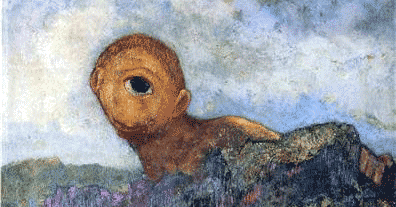
First attributed to Greek mythology and known for both malevolence and helpfulness towards humans, the cyclops is a one-eyed giant most famous for their appearance in Homer’s (800-701 BCE) Odyssey (c. 700 BCE). Cyclopes can be distinguished in Greek mythology by three categories: Hesiodic, after Hesiod, who wrote of three Cyclopes brothers as responsible for making Zeus’ thunderbolt; the Cyclopean Wall builders of Mycenaean architecture, characterized by enormous limestone boulders that supposedly only the massive Cyclops could lift; and the Homeric killer Cyclops as portrayed in the Odyssey. The latter is described in “Book 9” of the Odyssey, when the hero Odysseus travels to a distant land in which he encounters a group of one-eyed human-eating giants.
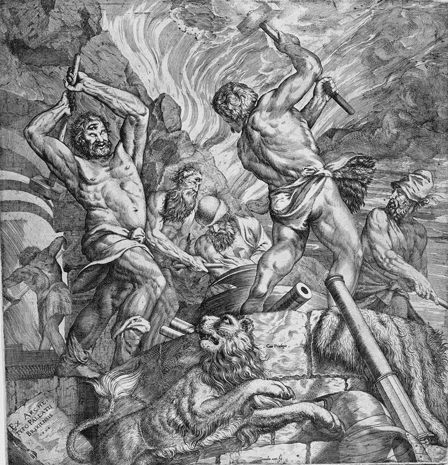
Homer’s cyclopes are depicted as troglodytic shepherds, living on undeveloped land and lacking in the virtues and traits of a supposedly civilized culture. When Odysseus sets out to explore the land on which he has arrived, he and twelve of his men enter a cave-dwelling, where they wait before encountering the inhabitant Polyphemus, a giant with a single orb-shaped eye in the centre of his forehead. As he enters his home, Polyphemus rolls a large stone in front of the cave’s entrance, trapping the men inside; after Odysseus tries and fails to reason with the giant, Polyphemus proceeds to brutally kill and devour two of the men in front of the rest. As Homer describes, “when the Cyclops had filled his great belly with the human flesh he had devoured, and the raw milk he washed it down with, he laid himself on the cavern floor.”
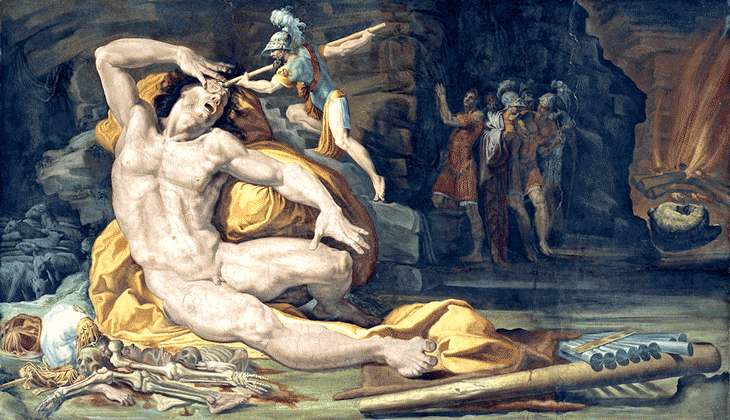
Polyphemus, satiated and sleeping on the floor of his cave, underestimates the danger posed by Odysseus, who climbs on top of the giant and blinds him with a sword to the single eye. The high drama and violence of the story’s pivotal event are captured in Pellegrino Tibaldi’s (1549-1596) The Blinding of Polyphemus (c. 1550-51), a strikingly detailed tableau. Though Tibaldi is not among the more celebrated or widely recognized artists of his time, his exceptional command of human anatomy and his invigorating use of colour, as well as the portrayal of depth within the background of the cave, make this painting a remarkable achievement in Renaissance mythology painting.
Flemish painter Jacob Jordaens (1593-1678) depicts the events subsequent to the blinding of Polyphemus, when Odysseus must strategize a way to escape the cave, in Odysseus in the Cave of Polyphemus (1635). Still unable to move the boulder, the resourceful Odysseus instructs his men to cling to the underside of the sheep; when Polyphemus lets the sheep out to graze, the men escape, unseen by the blinded Cyclops. Two figures are depicted in this scene as crawling under the sheep, hiding in plain sight as Polyphemus crouches over them.
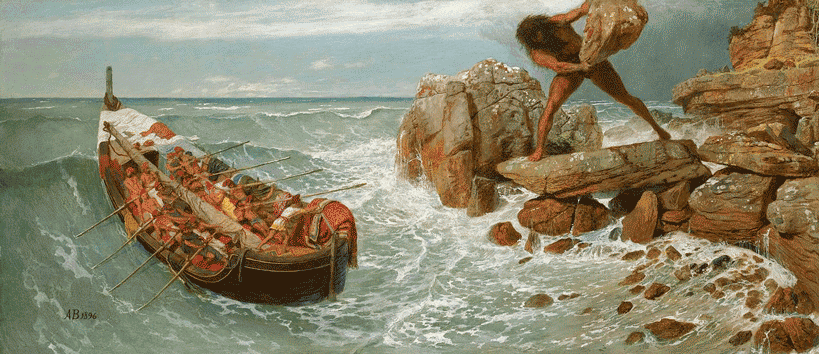
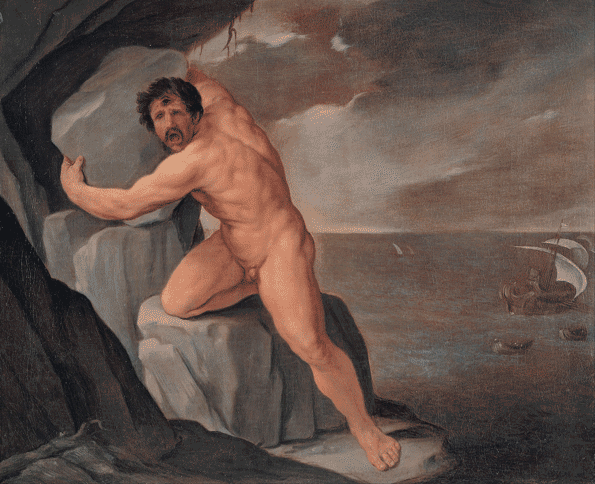
In the final events of Odysseus’ escape from the Cyclops’ lair, Odysseus and his men board their ship and sail away, taunting Polyphemus, who begins to lift massive boulders from the rocky shores and throw them towards the ship. Though Polyphemus is unsuccessful at sinking the ship, Odysseus in a moment of hubris identifies himself to the giant, an act of pride. As Polyphemus can then identify Odysseus, he can also curse him by name through the powers of his father, Poseidon.
Arnold Bocklin (1827-1901) portrayed this scene in Odysseus and Polyphemus (1896), creating tension with the suggestion of imminent danger, as a nearly vertical wave pulls the ship towards the shore, directly into the path of the truly gargantuan Cyclops in mid-swing of a boulder. Guido Reni’s (1575-1642) Polyphemus (1639-1640) depicts a less active version of the scene, in which a blinded Polyphemus gathers a boulder, while in the distance Odysseus’ ship floats away on placid waters. The giant is blinded, has lost control of his captives, and has only his rage to occupy his simple mind, a frustration captured sufficiently in the bewildered expression on the giant’s face. The tragic and somewhat pitiful image of Reni’s Cyclops would later be elaborated on in a hauntingly aberrant depiction of the giant in love.
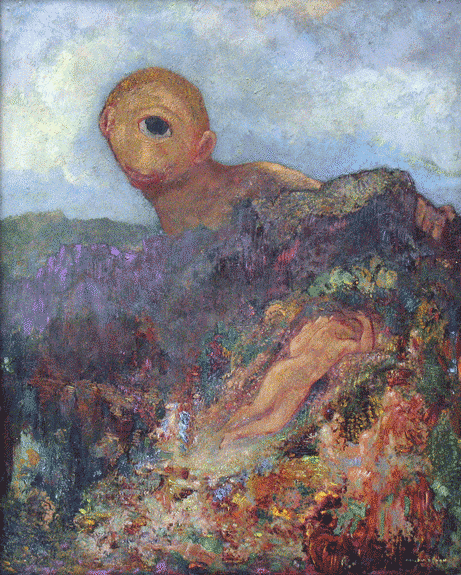
In stark contrast to the Homeric depictions of Polyphemus, French Symbolist painter Odilon Redon (1840-1916) portrayed the Cyclops in a style reflective of the artist’s semi-abstracted and dreamlike presentations that are noted as precursors to Surrealism. In Redon’s The Cyclops (c. 1898-1914), Polyphemus is depicted as larger and less human than any of the preceding illustrations. He towers over a mountain, his bulbous head and narrow shoulders making him seem childlike in appearance, while his lack of nose and chin appear amphibian or alien. He gazes lovingly at the sleeping Galatea, a naiad – a water-dwelling nymph – who lounges on a bed of flowers, unaware of the shy giant who watches her. Redon’s signature impasto application of a multitude of jewel tones adds to the eerie sense of the unnatural alongside the subject matter. The range of bright colours is jarringly acidic, while the focus on the eye of the giant, who looks onto an unaware naked woman is made more menacing for the paradoxical innocence of the giant’s smile and a slight tilt of the head, as the giant here symbolizes unrequited love. Redon’s works of dream-world depictions are typified by the psychoanalytic focus on the unexplained, the extraordinary, and the tumult of the human subconscious, all of which are exemplified in his singular depiction of the Cyclops.
In the next installment of the Gargantuan series, the author will examine the giant as an allegory of power in paintings of David and Goliath, and in Goya’s Colossus.
